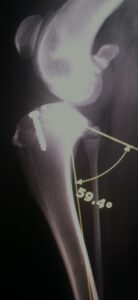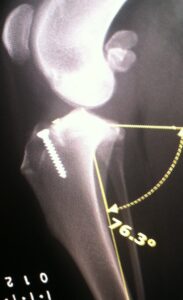-
Adopt
-
Veterinary Care
Services
Client Information
- What to Expect – Angell Boston
- Client Rights and Responsibilities
- Payments / Financial Assistance
- Pharmacy
- Client Policies
- Our Doctors
- Grief Support / Counseling
- Directions and Parking
- Helpful “How-to” Pet Care
Online Payments
Referrals
- Referral Forms/Contact
- Direct Connect
- Referring Veterinarian Portal
- Clinical Articles
- Partners in Care Newsletter
CE, Internships & Alumni Info
CE Seminar Schedule
Emergency: Boston
Emergency: Waltham
Poison Control Hotline
-
Programs & Resources
- Careers
-
Donate Now
 By Nick Trout, MA, VET MB, DACVS, ECVS
By Nick Trout, MA, VET MB, DACVS, ECVS
www.angell.org/surgery
surgery@angell.org
617-541-5048
Canine cruciate disease is arguably one of the most common orthopedic problems facing veterinarians today. In part, our awareness of stifle abnormalities has been heightened by an appreciation of effective surgical options for athletic or energetic dogs in the form of tibial plateau leveling osteotomy (TPLO) and tibial tuberosity advancement (TTA). These procedures tend to be used on skeletally mature dogs of any breed, but what if your patient is still growing? Cruciate ligament injuries can occur at any age and, from time to time, four- to eight-month-old dogs present with partial or complete cruciate tears. Should we wait until the proximal tibial growth plates are closed, or are we limited to stifle stabilization with a lateral suture technique?
Proximal tibial epiphysiodesis (PTE) offers an alternative technique to correcting the cranial cruciate ligament deficient stifle in growing dogs. Think of it as a “slow TPLO.” By prematurely closing the cranial portion of the tibia plateau using a carefully positioned cancellous screw, growth can be impeded while allowing the caudal portion to continue growing. So long as the dog has sufficient residual growth potential, the result is a progressive decline in the tibia plateau angle. In the same way as a TPLO, PTE can eliminate the need for a cranial cruciate ligament to counteract tibial thrust, thereby achieving dynamic stifle stabilization.
Accurate screw placement using a small lateral arthrotomy can be achieved intra-operatively using plain radiographs or fluoroscopic guidance. Eccentric screw placement has been reported to produce tibial valgus deviation, though this did not cause clinical signs or require corrective surgery. The technique is minimally invasive and can be performed on an outpatient basis. Standard postoperative restrictions apply, and dogs typically require follow-up radiographs every four to six weeks until growth plates close.
PTE is a simple, practical, well-tolerated procedure that answers the question of how to treat young dog cruciate disease. Owners should be aware that resolution of lameness requires growth, and this takes several weeks to achieve. They should also appreciate that this technique may not work in dogs over eight months of age or where the growth plate closes early. Screw removal has been reported to prevent overcorrection of the tibial plateau angle, though in my experience this has not proven necessary.
For large breeds or dogs that are destined to be active, PTE offers dog owners a fantastic alternative to a lateral suture technique or the frustration of waiting until skeletal growth is complete.
If you have questions about PTE, contact Dr. Trout at surgery@angell.org or 617-541-5048.

Image 1:
Immediate postoperative lateral stifle radiograph in a seven-month-old male giant schnauzer with a tibial plateau angle of just over 30 degrees.

Image 2: Three months later, the tibial plateau angle is less than 14 degrees, and clinical lameness has resolved.
References:
Proximal tibial epiphysiodesis to reduce tibial plateau slope in young dogs with cranial cruciate ligament deficient stifle. Vezzoni et al. VCOT 2008; 21:343-348.